Symptoms & Presentation of
Hereditary Angioedema

Hereditary angioedema (HAE) attacks are usually unpredictable and can be life-threatening. HAE attacks typically cause swelling of the skin/subcutaneous tissues, gastrointestinal tract, and upper airway, including larynx and oropharynx, some of which may be painful and functionally disabling. Almost all patients experience recurrent abdominal pain related to HAE.1-3
For OB-GYNs
HAE can be triggered due to hormonal changes.4
Angioedema presentation throughout the body
Face
- HAE attacks typically affect the face, extremities, and genitals2,4
- According to a 2006 survey, in 50 out of 158 patients, 29% of facial edema attacks led to laryngeal edema at least once, which can be a life-threatening event.2

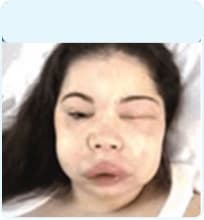
Photos courtesy of US Hereditary Angioedema Association. Haeimages.com.
Upper airway, including
larynx and oropharynx
- Attacks of the larynx can become fatal if left unmanaged4
- In the past, untreated laryngeal attacks resulted in mortality rates of up to 30%4
- In a survey of 209 patients, 50% experienced at least 1 episode of laryngeal angioedema symptoms during their lifetime5
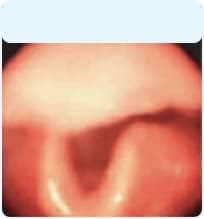
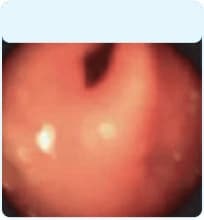
Photos courtesy of Bas M, et al. Allergy. 2006;61(12):1490-1492.
Those with undiagnosed HAE are at higher risk for mortality due to lack of proper intervention.6
Gastrointestinal (GI) tract and digestive system
- In a survey of 445 patients, abdominal attacks were the most commonly reported7
- An attack may present with mild to severe abdominal pain accompanied by vomiting and/or diarrhea5
- Based on a 2006 survey of 23 patients, untreated angioedema abdominal attacks required, on average, between 24 and 50 hours of bed rest8
- Gastrointestinal angioedema symptoms are often described as cramping or abdominal pain and may be the only sign of HAE for years before more visible swelling attacks present9
- GI attacks can involve the oropharynx, small intestine, and colon. Although very rare, involvement of the pancreas has been reported based on a review of 7 case reports published from 1992 to 2019 (pancreatitis, n=7 case reports)9
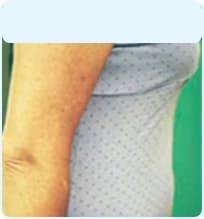
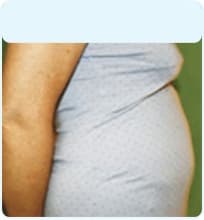
Photos courtesy of US Hereditary Angioedema Association. Haeimages.com.
The nonspecific nature of GI tract HAE attacks can be difficult to attribute to HAE, contributing to delays in diagnosis or misdiagnosis.9
Genitals
- From a 2006 survey of 201 patients, 65.2% of patients with skin swellings had genital swellings lasting about 3 days2
Extremities
- All attacks, including hands and feet, should be treated early in order to avoid potential dysfunction.6
Attacks to the extremities can prohibit patients from completing daily tasks and may cause patients to miss days of work.6
To better understand the impact HAE has on patients, use the Disease Burden Tool.
Hereditary angioedema attack triggers
HAE attacks can occur without warning. Here are some triggers that people with HAE have recognized5,10,11:
Stress
Physical trauma, surgery, or a dental procedure
Infection
Hormonal influence
Mechanical pressure
For OB-GYNs
Attack triggers for women with HAE may include menstruation, ovulation, pregnancy, and the use of estrogen-containing contraceptives. Nearly ⅓ of women have increased numbers of HAE attacks during or after menopause.6
Prodromal HAE symptoms are common.12
Some prodromes experienced by HAE patients before an attack include 12-14:
- Tingling sensation
- Erythema marginatum: a mild, nonpruritic rash
- Fatigue and malaise
- Nausea
- Muscle aches
- Neurologic symptoms
The most commonly reported prodrome is unusual fatigue and malaise. In a survey of 46 patients, 29 patients reported having unusual fatigue before their most recent HAE attack, and 26 reported unusual fatigue before most or all of their previous attacks.12

From a survey of 46 patients, 44 (96%) of the patients reported experiencing some sort of prodromal symptom before an HAE attack.12
The severity and frequency of HAE attacks may be different for each patient, and past attacks do not predict the severity of future attacks. Untreated HAE attacks can grow in severity, may take longer to resolve-and in the case of laryngeal attacks can be fatal.6,15
Differentiating HAE from other angioedema
It is important to differentiate HAE from other forms of angioedema because the approach to treatment is quite different.16
HAE attacks:
- Can occur without warning1,2
- Develop swelling slower, over 12 to 36 hours, then plateau, and resolve, on average, over 2 to 5 days if left untreated15,16
- Can migrate to other parts of the body during a single attack5,17
- Do not respond to antihistamines, corticosteroids, or epinephrine6
- May be exacerbated by exogenous estrogens and ACE inhibitors6
Sign up
Receive the latest HAE information and treatment considerations tailored to your level of experience treating patients with HAE.
